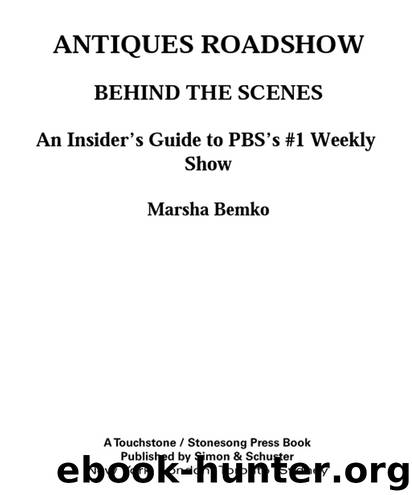Antiques Roadshow Behind the Scenes by Marsha Bemko

Author:Marsha Bemko
Language: eng
Format: epub
Published: 2019-02-01T16:00:00+00:00
Peter McGhee was responsible for bringing Antiques Roadshow to PBS.
One of the primary and most costly differences concerned the setup: The British version of Roadshow took two to three days. Moreno explained, “The lighting staff had to come in and build a grid to hang the lights. Then other people had to construct the set, and they used huge wooden panels. This took a lot of time and money and it just would not work here. For logistics and efficiency we decided we had to be able to do it all in one day. We also decided we had to work indoors and have weatherproof venues.”
It was determined that, by doing it this way, Antiques Roadshow could be much more efficient and cost-effective. I will discuss how this was done in chapter 3, “On the Road with Roadshow.” Suffice it to say, at this point a way was found to make everything lightweight and portable so that the set and lighting could be quickly and easily assembled and dismantled, and Antiques Roadshow could go from a completely empty space to being ready to tape in just one day. It was quite an achievement.
With these problems addressed, legal inquiries began. The BBC, which was accustomed to doing projects with WGBH, was agreeable, but they quickly hit a roadblock when they discovered that they had sold the North American rights to Antiques Roadshow in perpetuity to Farrell some fifteen years before.
As revealed earlier, Farrell had had no luck marketing Antiques Roadshow in the U.S., but Farrell’s luck changed when he “heard it through the antiques grapevine that WGBH was interested in the show.
“At this point, some fifteen years into the project,” Farrell continues, “I was grateful that anyone was interested in the show. I had learned about WGBH’s interest from Sam Pennington, founder of the influential Maine Antique Digest (M.A.D.), but I had purposefully stayed away from PBS as a possible home for Antiques Roadshow because I was interested in making money.”
Pennington had learned about WGBH’s interest from Moreno. She had called him wanting him to send her some back copies of the Maine Antique Digest so she could learn more about antiques and the antiques business. Moreno told Pennington about the Roadshow project, and Pennington said something like “Sounds like something this guy has been trying to do for years.”
Moreno knew of Dan Farrell but had been unable to reach him; Pennington offered to put the two of them together to discuss their mutual interest in the project. “Within a week,” Moreno says, “we started to talk.” Farrell sent the paperwork to Moreno, and it was clear that he owned the North American format rights to Roadshow. Then it came down to what Farrell wanted from WGBH, and at the top of that list was that Farrell wanted to work on the show. He had never done a television show before but he knew art and antiques so he thought he could make a continuing contribution.
This worked for Moreno too; she
Download
This site does not store any files on its server. We only index and link to content provided by other sites. Please contact the content providers to delete copyright contents if any and email us, we'll remove relevant links or contents immediately.
How to Be a Bawse: A Guide to Conquering Life by Lilly Singh(7394)
Spare by Prince Harry The Duke of Sussex(5076)
Millionaire: The Philanderer, Gambler, and Duelist Who Invented Modern Finance by Janet Gleeson(4384)
Machine Learning at Scale with H2O by Gregory Keys | David Whiting(4192)
Never by Ken Follett(3799)
Harry Potter 02 & The Chamber Of Secrets (Illustrated) by J.K. Rowling(3625)
The Heroin Diaries by Nikki Sixx(3496)
Urban Outlaw by Magnus Walker(3342)
Harry Potter and the Prisoner of Azkaban (Book 3) by J. K. Rowling(3304)
Fairy Tale by Stephen King(3221)
Japanese Design by Patricia J. Graham(3112)
The Man Who Died Twice by Richard Osman(2998)
The Club by A.L. Brooks(2863)
Stacked Decks by The Rotenberg Collection(2812)
Will by Will Smith(2795)
Harry Potter and the Deathly Hallows (7) by J.K. Rowling(2647)
Churchill by Paul Johnson(2509)
The Chimp Paradox by Peters Dr Steve(2302)
Borders by unknow(2232)
